Quantum canvases: a "painted debate" on free will
I gave an illustrated commentary on Robert Sapolsky's book which argues against free will
Quantum physicist Suzanne Gildert painting an artistic vision of conscious physics. Photo by Mychaylo Prystupa.
I like to paint future technology themes. A lot. I use paint to explore dimensions of consciousness that aren’t easily expressed in words. It reminds me of the fifteenth-century Leonardo Da Vinci, hunched over his drawings by candlelight, who imagined complex helicopters and parachute contraptions, centuries before they were actually made or understood.
So when a good friend of mine, University of Toronto management professor Ajay Agrawal, asked me earlier this week to participate in an online debate over two visions of free will, I jumped in, with my thoughts and my paintbrushes.
The question at hand: does quantum physics leave room for free will — or are we simply biological machines running complex code?
The event was the Creative Destructive Lab (CDL) reading group — where some two-hundred-plus intellectuals meet live on Zoom. We reviewed Robert Sapolsky’s book Determined — a bold, unapologetically biological and deterministic take on human behaviour. Sapolsky is a distinguished Stanford professor of biology, neurology, and neurosurgery. We were honoured to have him on the Zoom call too.
Sapolsky argues that free will is an illusion and every human decision — from acts of generosity to criminal violence — is the inevitable outcome of prior causes: genetics, childhood, hormones, trauma, brain chemistry, and circumstance. Our choices can even be detected in brain measurements before you’re even aware of them.
There is thus no “ghost in the machine,” he insists, just billions of neurons doing their deterministic dance — a complex chain of events, even if such a system is impossible to predict.
“Unpredictable is a very different thing than undetermined,” Sapolsky says.
“Consciousness is kind of a red herring for the simple reason that even though we can sit and consciously choose chocolate ice cream over vanilla ice cream… how did you become the sort of person who would prefer chocolate to vanilla? That is out of your control,” he stated.
Sapolsky’s ideas might seem like the antithesis of my quantum consciousness research, but in some important ways, we’re aligned. I agree with him that our biology, genes, and hormones all drive our choices. But I don’t think that accounts for all behaviour. I think there's one thing missing from his analysis: the influence of quantum processes on our decisions.
Sapolsky assumes quantum physics is essentially a closed case and irrelevant to consciousness. That’s where we part ways. Quantum mechanics is based upon the Schrödinger equation, which calculates probabilities. When a quantum state collapses due to measurement, the system chooses randomly from the probability distribution. But I argue that as quantum systems get larger and more interconnected, they may become conscious, and the Schrödinger equation may not apply anymore. It may need to be extended.
It could be a sign randomness isn’t random at all, but a signal of something deeper. Theoretical physicist David Bohm called such a deeper reality the Implicate Order: a hidden dimension where everything is connected and each moment is shaped by the whole. In this view, the visible world is just the surface and unfolds from a deeper wholeness that may hold not just everything you’ve ever been, but everything the universe has ever been too.
At Nirvanic, we’re investigating the choices that large quantum systems make to see if they’re different than what we’d expect from standard physics, and perhaps show a hidden force of conscious agency. We’re doing that by putting a quantum algorithm in a feedback loop with a test robot. Our guiding model, Quantum Conscious Agency Theory (QCAT), asks whether a quantum-controlled robot will act in a way that statistically differs from its classical counterpart.
Nirvanic founder Suzanne Gildert speaking online to a CDL Reading Club about her paintings depicting two visions of free will. Photo by Mychaylo Prystupa.
Since the CDL reading group often involves creative role play, I went all in as an “art dealer” explaining my point of view from an artistic perspective, presenting two original paintings (made by yours truly).
The two paintings
One painting, shown on the left of the easel below, depicts the standard worldview of physics expressed in Sapolsky’s book. The other, shown on the right of the easel, depicts Nirvanic’s worldview on how quantum consciousness and free will might differ from this.
Both paintings have grey broad brushstrokes representing predictable, classical physics. Decorative gold lines on top represent quantum physics. I like to think quantum physics as an ‘add on’ or a modification to our existing physics. Overlayed are circuits that depict scientific tools and technologies that we’ve developed to measure and probe aspects of that background reality. A central square on both shows real data taken from Nirvanic’s quantum experiments.
But here’s how they differ:
On the left painting, the data shown is from Nirvanic’s simulation of a quantum system run by a digital algorithm. The eye is closed, iconographic and colourless. It’s my interpretation of Sapolsky’s view, which seems to be that quantum systems collapse “randomly” into states in ways that are not well understood, but clockwork even if very complexly so. The brain is a machine. No loophole for consciousness. Just input-output. Computation.
The right painting illustrates my conjecture that new quantum physics may reveal how our consciousness emerges. It shows data from our actual quantum computer experiments. The areas inside the golden quantum lines fill with iridescent and pearlescent paints that shimmer and change colour and reflectivity as you look at it from different angles. Its central “conscious eye” is open, vivid and colourful. It looks back at you. An observer embedded in the universe.
Sapolsky’s reaction?
The honourable Stanford professor smiled, but was taken aback by my paintings. Referencing Einstein, he said our conscious AI research would be:
“…spooky as hell if a quantum system were beginning to generate that.”
I agree. But perhaps no weirder than explaining to someone in the 1500s — perhaps even Da Vinci — that invisible signals, called radio waves, would someday day carry human conversations through the air, across continents, as if distance made no difference at all.
Perhaps consciousness is a field our brains can tune into — and one our technology might tap into one day too. So let’s see what our experiments turn up.
Stay tuned, friends.
-Suzanne
P.S. Below are some of my other paintings, if anyone’s curious. A friend mused that maybe I should sell my art to fund our conscious research. 🤷♀️



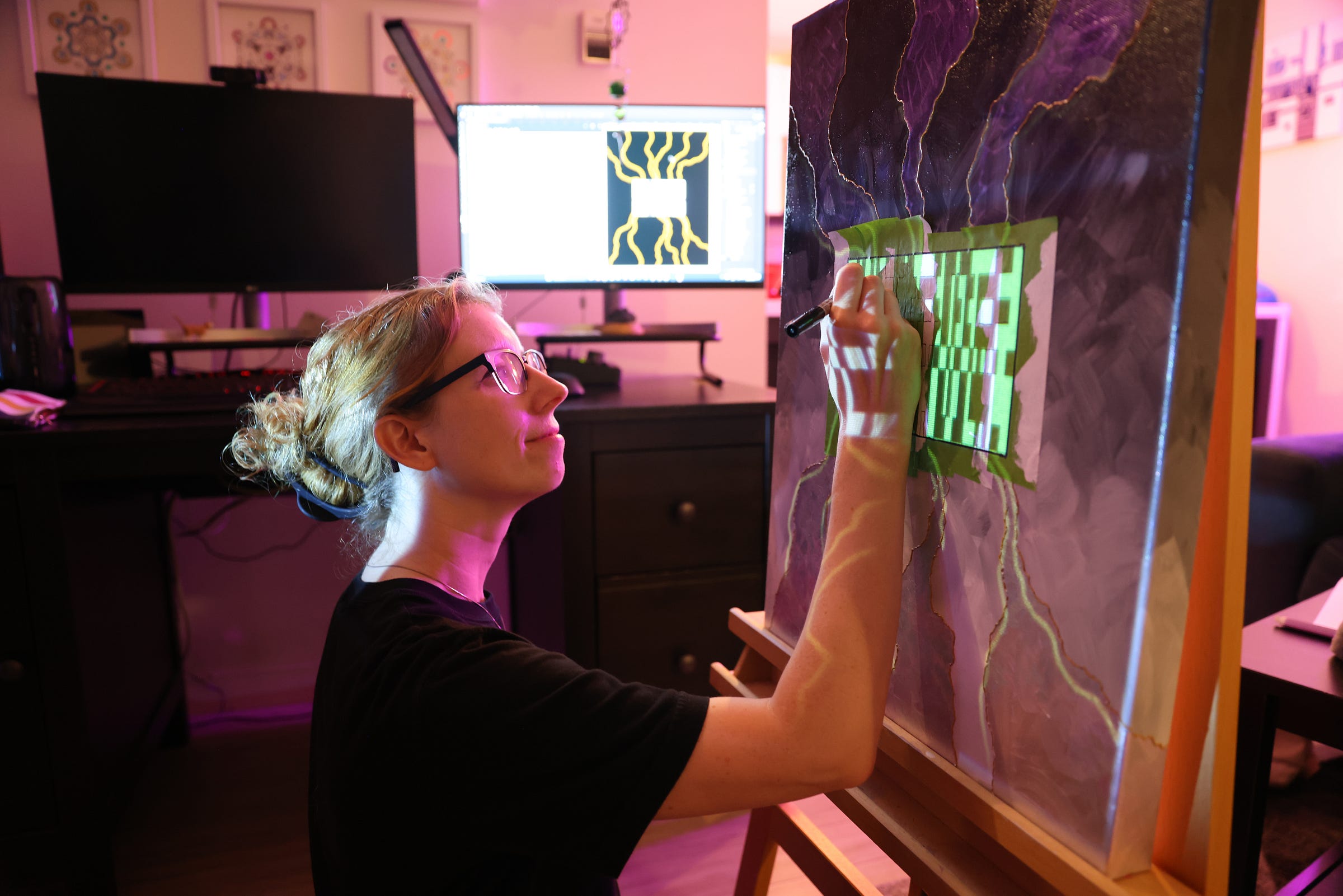
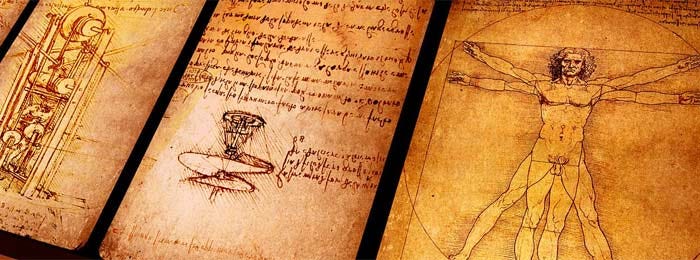
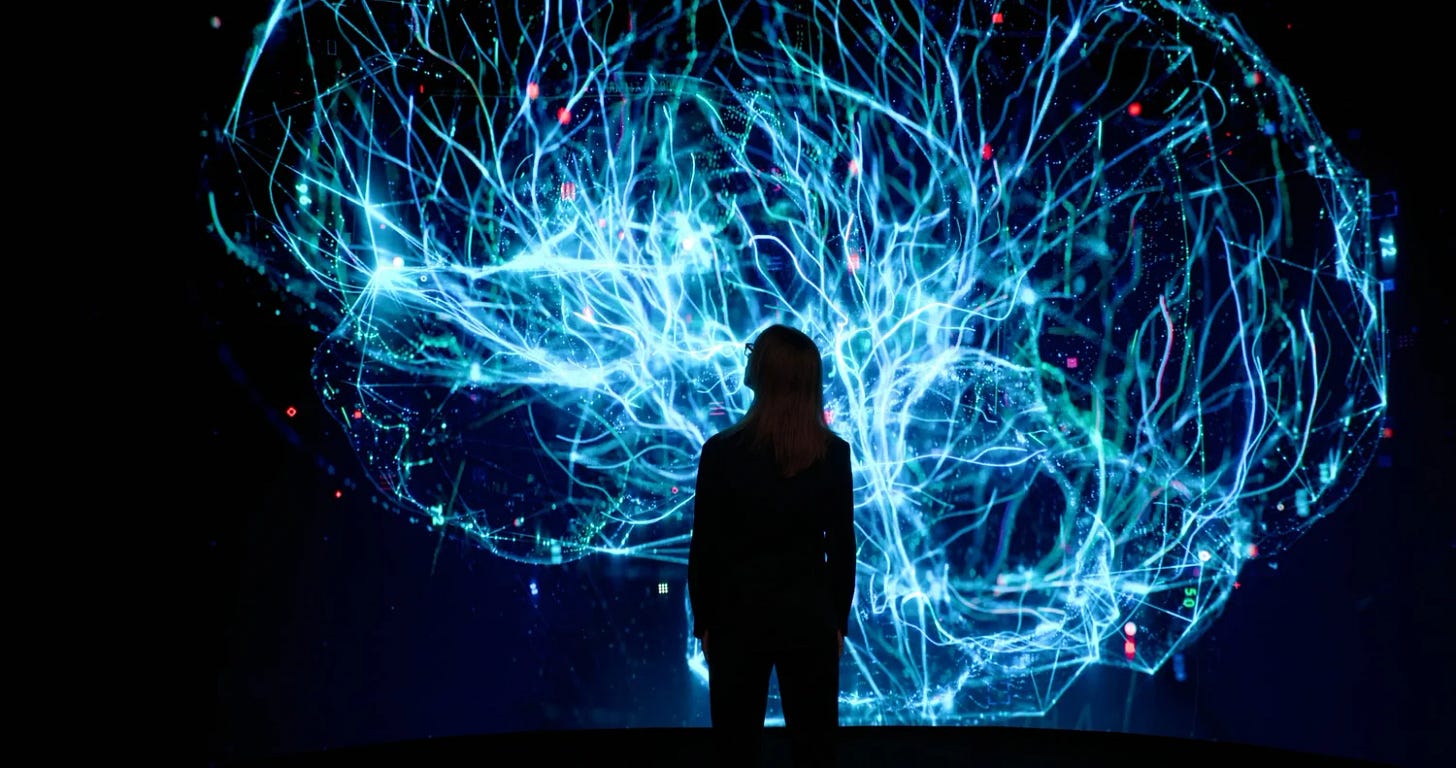

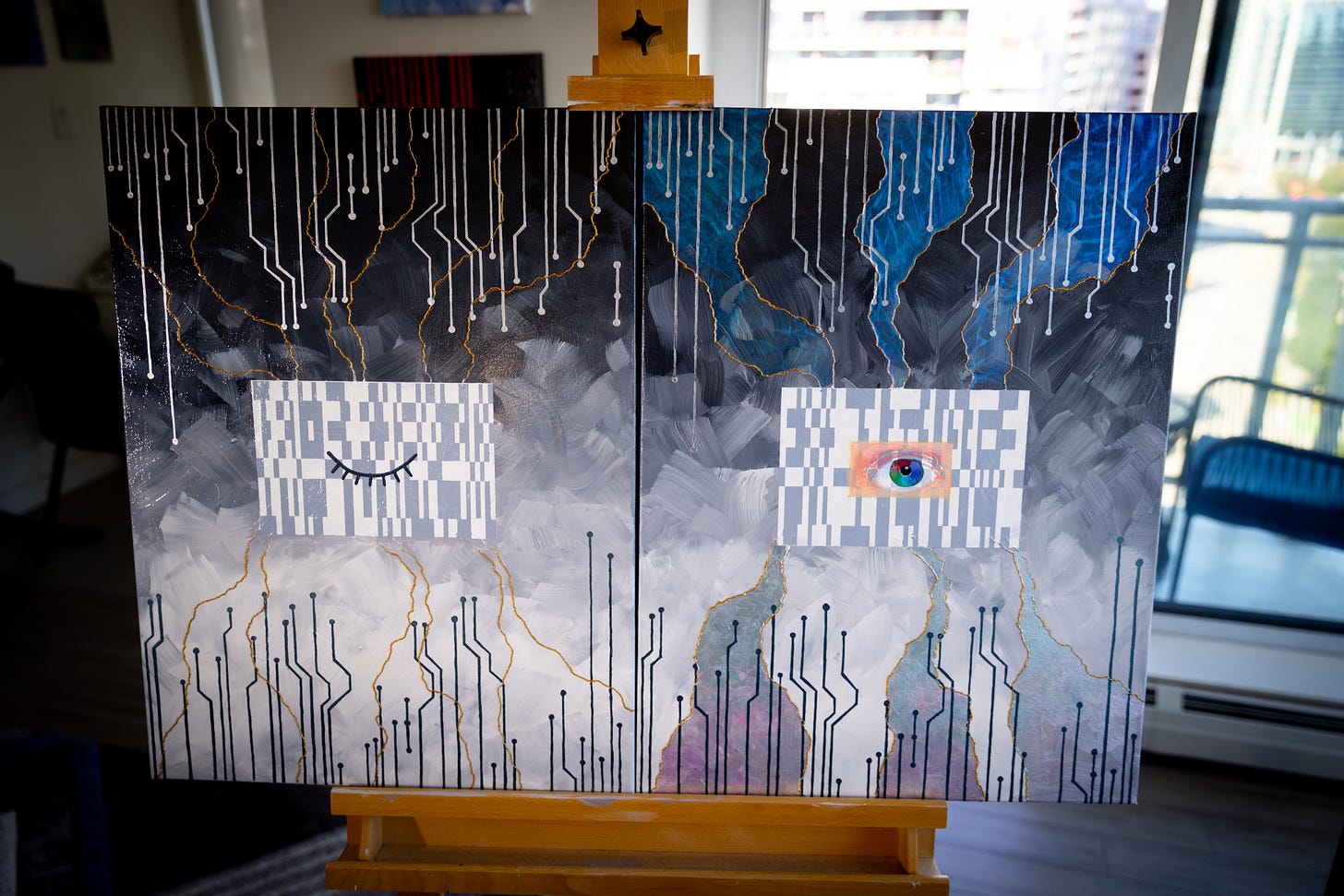
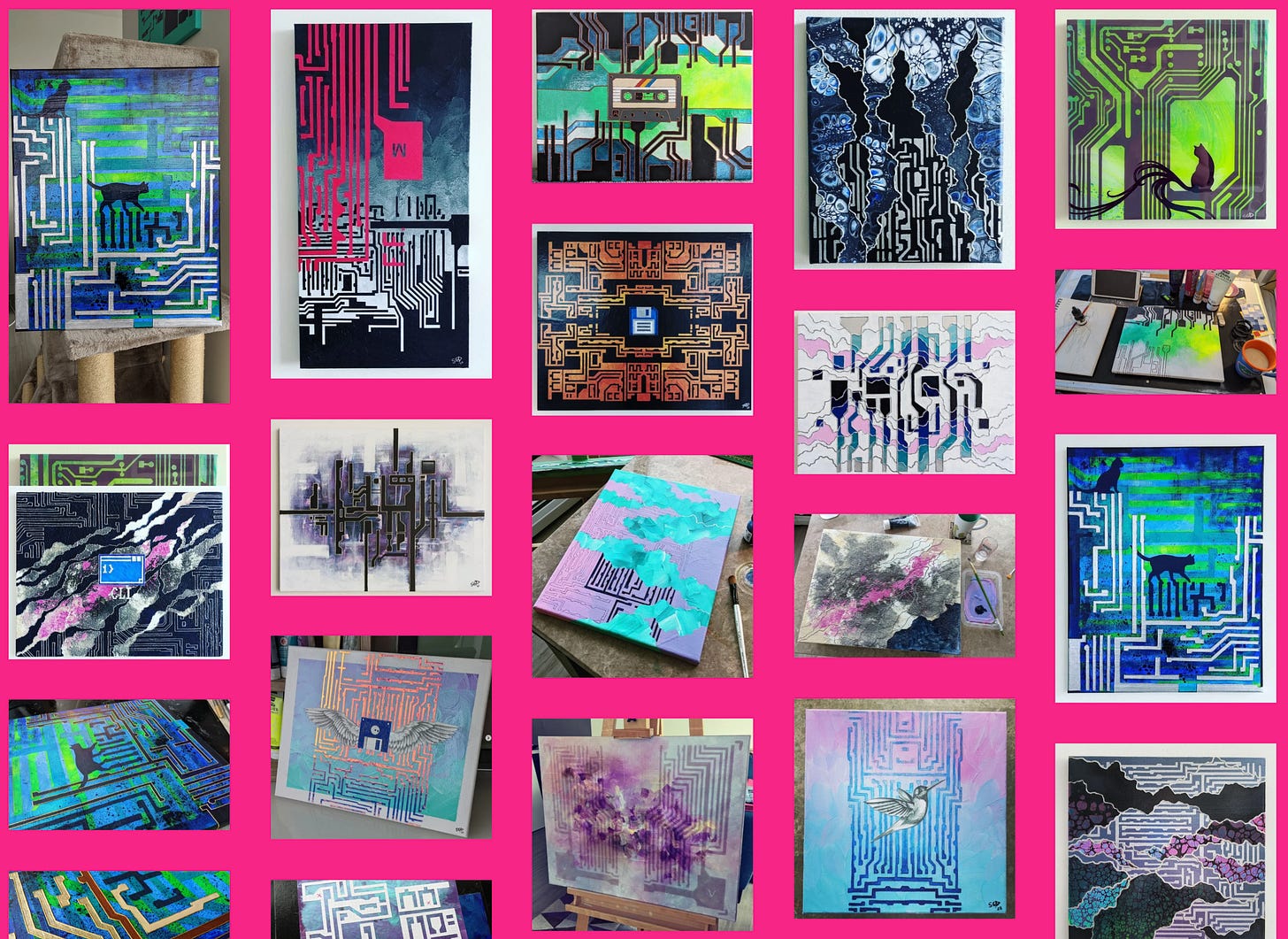
During my research for my doctorate, I discovered Evolutionary Psychology, a way of thinking about our species' evolution. Our brain is a pattern recognition device. We have followed patterns via our current and former brilliant forebears deep into the quantum world that underlies reality as currently known/understood, and increasingly leverage it into more sophisticated applications and especially questions. As a long-term practitioner of counseling, psychotherapy, hypnotherapy, and related approaches to assist us in navigating our lives, I have a working conclusion that most humans live in a simulated reality, often unconscious of that condition. I will personally attest that waking up is hard to do.
Now we begin to explore the underlying quantum reality on which, or in which we live, very curious about our explorations and valid conclusions of findings. Fantastic journey. I suggest we avoid premature conclusions about actuality. To me, we have just begun to reverse-engineer our discoveries and possible connections to consciousness. Thanks so much to everyone for your research and vigorous debates.
I would purchase one for sure, love all that you do👍🙏🌀🌸🔱💯